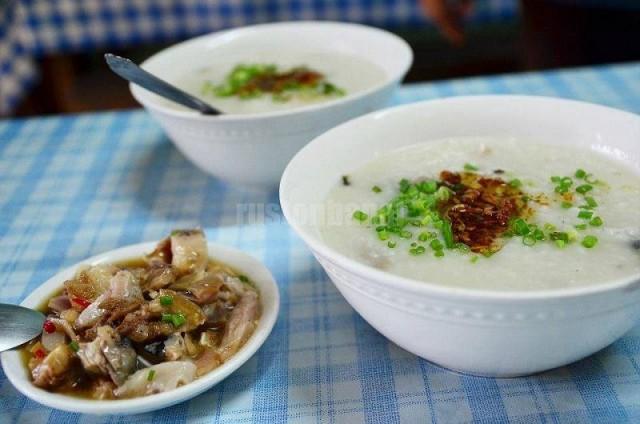Sisig with egg and mayo? Thanks, but Kapampangans aren't having any of that
For decades, sisig has gained popularity more than any other Filipino dish in the country. There are a myriad of versions of the dish that came from Pampanga, depending on where and who prepares it.
But the Kapampangans won't have any of it.
The Angeles City government had proclaimed sisig as “Intangible Cultural Heritage” by the Sangguniang Panglungsod through Ordinance No. 405, Series of 2017 of Angeles City, officially claiming it as an original Kapampangan creation in order to protect it from further cultural appropriation — fusion anyone?
Over the weekend, the annual Sisig Fiesta took place at Crossing on MacArthur Highway in Angeles City where a sisig exhibition by different Pampangueño cooks and food connoisseurs took place.
_2018_04_30_11_29_36.JPG)
Established in 2003, the sisig fest is an official event dedicated to acknowledging the dish as part of the ways of life of the Kapampangans.
"We want to tell the people that sisig is part of our cultural history and heritage and therefore, it is an important element of our identity as Kapampangans," said Angeles Mayor Ed Pamintuan.
Recorded history in the colonial period confirms what the mayor said. The word "sisig" can be traced to as early as 1732 in a Kapampangan dictionary compiled by Augustinian Fray Diego Bergaño. In it, sisig was defined as a "salad, including green papaya, or green guava eaten with a dressing of salt, pepper, garlic, and vinegar."
According to Kapampangan scholar Mike Pangilinan, the SÍSIG BÁBÎ — ‘pork sísig’ — was originally made of boiled pig’s ears and tail mixed with onions and dressed in spicy vinegar.
It was believed that sisig was specifically designed for pregnant mothers; the cartilage in the pig’s ears and tail helping in the bone development of the child in the mother’s womb.
Although sisig was still very much a dish for expectant mothers in many Kapampángan homes until the early 1980's, something happened in Angeles City in the late 1960's that changed sisig forever.
Sisig was first served as a bar chow, or pulutan as we Filipinos like to call food that accompanies alcoholic drinks.
Lucing Cunanan — or Aling Lucing as we now refer to the genius who innovated the sisig — decided to use the pig's cheeks instead of the traditional pig's ears to cater the huge demands of customers that flocked the Angeles crossing.
According to Aling Lucing's daughter Zeny Cunanan, in the '70s, they would obtain for free discarded pig’s head at the abattoir in the former US Airforce Base at Clark and used these for their sisig.
The present-day form of sisig can be attributed to a certain Benedicto Pamintuan, who introduced the dish on a sizzling plate that would become popularly known worldwide.
In 1980, the Pamintuan family brought the sizzling plated sisig to Metro Manila by way of Benedicto’s mom, Lilia, who served the sizzling version at her restaurant in Sta. Mesa, Manila. Soon it swept Metro Manila off its feet.
At the same time, Dan Táyag, another Angeleño, also began serving the sizzling sisig at Trellis Restaurant in Diliman, Quezon City.
The New York Times calls our beloved sisig "arguably the best pork dish on earth." Sisig, that delicious delicacy made by boiling and chopping up a pig's head and ears and marinating the pork in vinegar, salt and pepper before serving, is also one of the purely Kapampangan dishes that has gained international acclaim in recent years.

It's not only in Angeles where variants of sisig can be found. In lower Pampanga — that part of the province near the Guagua-Sasmuan River — sisig is prepared with boiled pig ears, onions, labuyo and pepper. These are then soaked in vinegar and soy sauce while maintaining the crunchy texture of the pig's ears.
Because this is solely prepared for a conceiving mother, the raw texture of non-grilled pork does not have a commercial marketability.
Edward Lusung, owner of the famous Conching restaurant in Guagua in lower Pampanga, exclusively served this type of sisig but the huge demand for the grilled version made him decide to serve both versions.
"I don't have a secret recipe. I'm just complying with the way my ancestors taught me how to cook it through the combination of a sugar cane vinegar from Angeles, liver cooked in adobo while chopped with chile and onions, he said.
But acceptable innovation ends there. Says Lusung, "Egg and mayonnaise is a big no! This is a shortcut and [a disrespect for old school Kampampangan cooking]. I was taught by my grandfather and grandmother how to cook it religiously".
Angeles tourism officer Joy Cruz agrees. "It's a total disrespect because perfecting the sisig to have its authentic taste [and chewy texture] is something you earn from experience and acknowledging the history of how it evolved from the Kapampangan sensibilities as a heirloom recipe," she said.
It is believed that the introduction of egg and mayonnaise into sisig started when it was introduced in Manila alongside with the silog meals offered by fast food restaurants. The preparation of the original sisig makes it impossible to simulate in a fast-paced city, where restaurants resorted to using an alternative to the savory effect of a chicken liver, thus using an egg or a mayonnaise.
As Mike Pangilinan said, "For us Kapampángans, cooking is not a mere hobby or a past time. It is an essential part of our identity. It is an expression of who we are as a people. It is our soul. Therefore we get hurt and angry whenever somebody steals our soul and identity and calls it simply Filipino food rather than Kapampangan dish. Worse is when you twist it and play around with it to the point that we can no longer recognise ourselves in it." — LA, GMA News





